Book Review: Fever Pitch by Nick Hornby
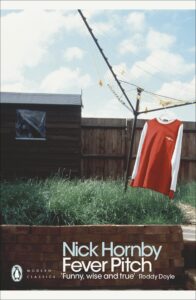 With the end of the 1991/92 season, the format of football in England shifted seismically; Leeds United were the last Football League Division One Champions and in 1992/93 the FA Premier League was born, to change forever the soccer landscape in this country. 1992 also saw the release of Fever Pitch by Nick Hornby, which transformed the way football literature was viewed to become a seminal work in sports writing.
With the end of the 1991/92 season, the format of football in England shifted seismically; Leeds United were the last Football League Division One Champions and in 1992/93 the FA Premier League was born, to change forever the soccer landscape in this country. 1992 also saw the release of Fever Pitch by Nick Hornby, which transformed the way football literature was viewed to become a seminal work in sports writing.
The book in structure is divided into three section, 1968 – 1975, 1976 – 1986 and 1986 – 1992, with a brief Introduction. Within each section, Hornby highlights certain fixtures to detail the relationship between his life and what he sees as the intrinsic links with football, rather than a ‘match-report’ format. Hornby is clear in the introduction to the book as to his reasons for writing Fever Pitch, detailing that it “…is an attempt to gain some kind of angle on my obsession…also, in part, an exploration of some of the meanings that football seems to contain for many of us…about being a fan…”
When first reading this book twenty years ago, it was a revelation to read something that I could relate to in terms of the passion, fanaticism and obsession with ‘my’ team. Hornby had captured the enthusiasm of going to your first game and how it hooks you in, continuing the story through adolescence to adulthood and the ‘highs and lows’ that occurred both in supporting your team and the angst associated with growing-up. The book had a ‘current’ feel to it as it was written and published with a backdrop in which the English game was still recovering and coming to terms with the fallout from the (then) recent events of Heysel, the Bradford City fire and Hillsborough.
Reading Fever Pitch again at the end of the 2012/13 season, Hornby’s Arsenal find themselves at the Emirates Stadium in a league that is a global brand, with a team where English players are in the minority and the days of epic FA Cup ties requiring numerous replays, are a thing of the past. This change in the football landscape over the last twenty years perhaps explains why for me reading the book second-time around, the focus fell more upon Hornby’s emotional journey through depression and his personal story than the footballing context. That said, Fever Pitch is still a hugely influential read in football literature, but given the shift that has occurred in the English game and its implications for clubs and all those involved in the sport, including fans, the time is surely ripe for a second football offering from the author. Unfortunately, it is unlikely to be a Fever Pitch 2 as Hornby has said that the success of the original altered forever his relationship with the club, in that he could no longer write from the perspective of the fan. Therefore, Fever Pitch should be appreciated for the classic it is and will continue to be in the future.
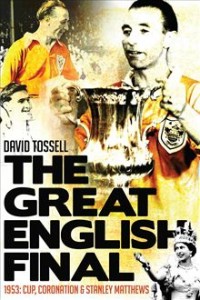 David Tossell’s book about the 1953 FA Cup Final when Stanley Matthews’ Blackpool beat Bolton 4-3 makes a grandiose but puzzling claim. It says that the “…legendary game continues to occupy a prominent place in English football legend…” (sic) because it has, “…come to represent a Golden Age…” But it doesn’t even leave things at that. Not content with such a mighty claim about the game’s footballing pedigree, it makes wider claims for the match that cannot possibly be substantiated. The raw material for a really good story about football is there all right, but he nearly messes it up by trying to bring in too many different themes. Happily, he is saved by the fact that, finally, the Final delivered.
David Tossell’s book about the 1953 FA Cup Final when Stanley Matthews’ Blackpool beat Bolton 4-3 makes a grandiose but puzzling claim. It says that the “…legendary game continues to occupy a prominent place in English football legend…” (sic) because it has, “…come to represent a Golden Age…” But it doesn’t even leave things at that. Not content with such a mighty claim about the game’s footballing pedigree, it makes wider claims for the match that cannot possibly be substantiated. The raw material for a really good story about football is there all right, but he nearly messes it up by trying to bring in too many different themes. Happily, he is saved by the fact that, finally, the Final delivered.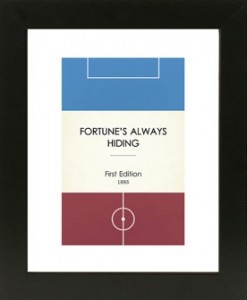 In terms of the inspiration for the idea, the partners had been playing around with various pastiches of classic Penguin books, when it suddenly occurred to them that the ingenious colour-coded tricolours on the Penguin and Pelican covers, designed by Edward Young in the 1930s, would lend themselves to the world of football. So, they began by filling in the panels with colours, say claret and blue, and then coming up with a line from a song or a reference understood by the club’s fans. This was then inserted as the title of the book; in West Ham United’s case ‘Fortune’s Always Hiding’. This struck the partners as being a poignant memoir detailing the story of a football team. Woods and Evans deliberately avoided current, time-sensitive references and just went for classic, literary-inspired titles. In addition, the well-recognised markings of the six-yard box and centre-circle were added to the panels; with the print completed by the inserting of the wording ‘First Edition’, which signified the year the club was formed.
In terms of the inspiration for the idea, the partners had been playing around with various pastiches of classic Penguin books, when it suddenly occurred to them that the ingenious colour-coded tricolours on the Penguin and Pelican covers, designed by Edward Young in the 1930s, would lend themselves to the world of football. So, they began by filling in the panels with colours, say claret and blue, and then coming up with a line from a song or a reference understood by the club’s fans. This was then inserted as the title of the book; in West Ham United’s case ‘Fortune’s Always Hiding’. This struck the partners as being a poignant memoir detailing the story of a football team. Woods and Evans deliberately avoided current, time-sensitive references and just went for classic, literary-inspired titles. In addition, the well-recognised markings of the six-yard box and centre-circle were added to the panels; with the print completed by the inserting of the wording ‘First Edition’, which signified the year the club was formed.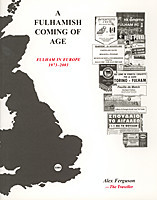 Alex Ferguson started watching Fulham in the 1950s and did so through the many ‘ups and downs’ the club endured, until his untimely death in 2006. Alex became one of the most recognised, if not the most renowned fan of the club, following the ‘Lilywhites’ wherever and whoever they played. No matter if it was the first-team, the reserves, the youth team, Fulham Ladies – league, cup, testimonial, friendly; Alex was there. He also watched England at all levels with the same enthusiasm and fanaticism and his journeys with both club and country earned him the moniker of ‘The Traveller’.
Alex Ferguson started watching Fulham in the 1950s and did so through the many ‘ups and downs’ the club endured, until his untimely death in 2006. Alex became one of the most recognised, if not the most renowned fan of the club, following the ‘Lilywhites’ wherever and whoever they played. No matter if it was the first-team, the reserves, the youth team, Fulham Ladies – league, cup, testimonial, friendly; Alex was there. He also watched England at all levels with the same enthusiasm and fanaticism and his journeys with both club and country earned him the moniker of ‘The Traveller’.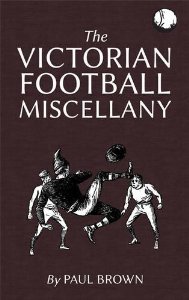 Back in 2012, Paul Brown edited an anthology of Victorian football writing, titled
Back in 2012, Paul Brown edited an anthology of Victorian football writing, titled  Take all the years you’ve watched your club and then try and pick the best eleven. A time-honoured debate for any football fan, one which can provide heated discussion whilst on the longest of away trips or during the quietest of post-match pints. Quite simply this is the premise for Crystal Palace FC 1969-1990 – A Biased Commentary.
Take all the years you’ve watched your club and then try and pick the best eleven. A time-honoured debate for any football fan, one which can provide heated discussion whilst on the longest of away trips or during the quietest of post-match pints. Quite simply this is the premise for Crystal Palace FC 1969-1990 – A Biased Commentary. Northern Monkeys was first published by ThinkMore in 2012 with the limited edition run, selling out. Given this success a second edition was published in 2013 which contained some addition material. This review is based on the latest edition.
Northern Monkeys was first published by ThinkMore in 2012 with the limited edition run, selling out. Given this success a second edition was published in 2013 which contained some addition material. This review is based on the latest edition.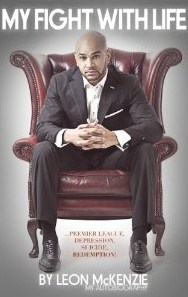 Robert Enke (2009), Dale Roberts (2010), Gary Speed (2011) – three men from the world of football who in recent years took their own lives. That list has nearly been added to by ex-players such as Dean Windass and the author of My Fight with Life, Leon McKenzie, who have both attempted suicide.
Robert Enke (2009), Dale Roberts (2010), Gary Speed (2011) – three men from the world of football who in recent years took their own lives. That list has nearly been added to by ex-players such as Dean Windass and the author of My Fight with Life, Leon McKenzie, who have both attempted suicide. Where do you start with this review? In finishing reading this book and reflecting on the experience, my views and thoughts have been many and varied, which has subsequently made the task of writing a critique a difficult one. So let’s start with some basics.
Where do you start with this review? In finishing reading this book and reflecting on the experience, my views and thoughts have been many and varied, which has subsequently made the task of writing a critique a difficult one. So let’s start with some basics. With the advent of books about football terrace culture in the late 1990’s from writers such as John King and more recently Dougie Brimson, this genre has gradually gained an acceptance and recognition in the literary world. Chris Brown is a Bristol Rovers fan, who in the 1970’s was a skinhead on the terraces in the Tote End at Eastville (Rovers home ground up until 1986), who detailed his experiences, the music and fashion of the time in his autobiographical book Bovver (published 2001); it was subsequently updated and released in 2009 as Booted and Suited. Following on from the success of these books, Chris Brown has written his first novel, Guilty Tiger, which draws on his Bristol roots and some of the themes of his earlier work.
With the advent of books about football terrace culture in the late 1990’s from writers such as John King and more recently Dougie Brimson, this genre has gradually gained an acceptance and recognition in the literary world. Chris Brown is a Bristol Rovers fan, who in the 1970’s was a skinhead on the terraces in the Tote End at Eastville (Rovers home ground up until 1986), who detailed his experiences, the music and fashion of the time in his autobiographical book Bovver (published 2001); it was subsequently updated and released in 2009 as Booted and Suited. Following on from the success of these books, Chris Brown has written his first novel, Guilty Tiger, which draws on his Bristol roots and some of the themes of his earlier work.